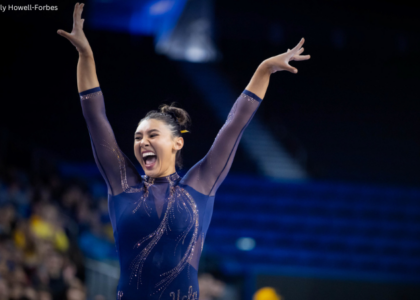This year’s senior session of the Nastia Liukin Cup was packed full of four- and five-star recruits from the classes of 2024 and 2025. The national champion Oklahoma Sooners had the highest number of competitors with six, which just so happens to field a full lineup in college competition. To illustrate the differences between level 10 and NCAA judging, I re-evaluated the six Sooner routines on each event using NCAA rules and judging norms to determine how their routines might score in college. Then, I calculated their team score, dropping the lowest score on each event.
I give you… The Junior Sooners!
| Gymnast | Vault | Bars | Beam | Floor | All Around |
| Mackenzie Estep ‘25 | 9.800 | 9.750 | 9.950 | 38.600 | |
| Elle Mueller ‘24 | 9.850 | 9.850 | 9.650 | 9.850 | 39.200 |
| Ella Murphy ‘25 | 9.750 | 9.750 | 9.700 | 9.850 | 39.050 |
| Kamila Pawlak ‘25 | 9.750 | 9.800 | 9.800 | 9.800 | 39.150 |
| Lily Pederson ‘24 | 9.750 | 9.800 | 9.850 | 38.950 | |
| Kelsey Slade ‘24 | 9.750 | 9.750 | 38.900 | ||
| Total | 48.90 | 48.950 | 48.750 | 49.200 | 195.800 |
With a team score of 195.800, the Junior Sooners would sit at No. 39 in the national rankings (with the understanding that it is a single score and not a full NQS. However, it’s important to consider the key differences between level 10 and NCAA judging.
For example, most (but not all) of these routines start from a 10.1 rather than a 10.0, as level 10 bonus rules are different. Generally, routine composition for level 10 on bars, beam, and floor is more difficult, with more skills and requirements to start from a 10 or a 10.1. I would expect most gymnasts to do easier routines than what we saw at the NLC when they transition to college. Because of this, I ignored any turn deductions on floor when I redjudged these routines. While turns are a requirement for level 10 on floor, they aren’t in college and tend to be a deduction trap, so most NCAA gymnasts opt out of that skill.
Level 10 judges also tend to be more comfortable taking more and larger deductions for form errors. This shouldn’t be the case since most NCAA judges also judge level 10 athletes, but I digress. In college, judges rarely take more than a half tenth for a form break and sometimes overlook minor knee and feet issues, especially in tumbling skills.
Comparing the scores and performances of Lily Pederson and Elle Mueller is a good example of this. Judging with NCAA leniency put Pederson at +0.775 over her NLC all-around score, where Mueller was only a quarter-tenth higher. Pederson had great gymnastics but lots of small knees, legs, and foot form deductions but didn’t take (as is typical in college).
Meanwhile, Mueller, who looked very polished in her performance, saw a much smaller swing in her score since her deductions happened to be ones that are typically taken in college. By not deducting the small form breaks, we scrunch all the athletes near the top rather than creating appropriate separation, and room for improvement, when appropriate. Kelsey Slade also finished ahead Pederson at the NLC but behind her in my rankings for the same reason.
You can also see my vault scores were all very similar, as NCAA judges rarely take any deductions for height, distance, or form breaks on or before the table. Again, this clusters the scores together in college, especially since there is only a half-tenth advantage to the Yurchenko one and a half in college (9.95 vs. 10.0 start value), compared to a full tenth advantage in level 10 (10.0 vs. 10.1 SV). NCAA judges also rarely take landing position deductions on dismounts or double-flipping saltos and will rarely, if ever, take more than one tenth, even for a large hop or step, which should be a flat two tenths. These NLC judges on vault showed an appropriate range of deductions for form errors throughout the vaulting phases, as well as appropriate landing deductions.
The last major change is that some of these athletes had composition deductions or 9.9 start values in college, rather than the 10.0 start value. For example, Murphy’s floor routine would start from a 9.9 because a front pike is worth a B in level 10 and an A in college, which impacts her bonus combinations. She also has an “up to the level” composition deduction, which apply for both level 10 and college, but her 10.1 start value with the composition deduction effectively puts her at a 10.0 start value, rather than the effective 9.9 start she would have in college.
Regardless, I think we can expect great things from the Junior Sooners as well as all the other NLC competitors, and I look forward to seeing them compete in the NCAA in the coming years.
READ THIS NEXT: Elle Mueller and Ella Kate Parker Crowned Nastia Liukin Cup Champions
Article by Rhiannon Franck
Rhiannon Franck is a former national-rated NAWGJ women’s gymnastics judge with over 15 years of USAG judging experience and nine seasons judging NCAA gymnastics. Outside of gymnastics, Franck works at a university as a nursing professor and loves to travel.




2 comments